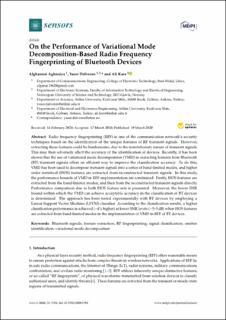| dc.contributor.author | Aghnaiya, Alghannai | |
| dc.contributor.author | Dalveren, Yaser | |
| dc.contributor.author | Kara, Ali | |
| dc.date.accessioned | 2020-03-23T14:02:12Z | |
| dc.date.available | 2020-03-23T14:02:12Z | |
| dc.date.created | 2020-03-22T13:40:36Z | |
| dc.date.issued | 2020 | |
| dc.identifier.issn | 1424-8220 | |
| dc.identifier.uri | https://hdl.handle.net/11250/2648175 | |
| dc.description.abstract | Radio frequency fingerprinting (RFF) is one of the communication network’s security techniques based on the identification of the unique features of RF transient signals. However, extracting these features could be burdensome, due to the nonstationary nature of transient signals. This may then adversely affect the accuracy of the identification of devices. Recently, it has been shown that the use of variational mode decomposition (VMD) in extracting features from Bluetooth (BT) transient signals offers an efficient way to improve the classification accuracy. To do this, VMD has been used to decompose transient signals into a series of band-limited modes, and higher order statistical (HOS) features are extracted from reconstructed transient signals. In this study, the performance bounds of VMD in RFF implementation are scrutinized. Firstly, HOS features are extracted from the band-limited modes, and then from the reconstructed transient signals directly. Performance comparison due to both HOS feature sets is presented. Moreover, the lower SNR bound within which the VMD can achieve acceptable accuracy in the classification of BT devices is determined. The approach has been tested experimentally with BT devices by employing a Linear Support Vector Machine (LSVM) classifier. According to the classification results, a higher classification performance is achieved (~4% higher) at lower SNR levels (−5–5 dB) when HOS features are extracted from band-limited modes in the implementation of VMD in RFF of BT devices. | en_US |
| dc.language.iso | eng | en_US |
| dc.publisher | MDPI | en_US |
| dc.rights | Navngivelse 4.0 Internasjonal | * |
| dc.rights.uri | http://creativecommons.org/licenses/by/4.0/deed.no | * |
| dc.title | On the Performance of Variational Mode Decomposition-Based Radio Frequency Fingerprinting of Bluetooth Devices | en_US |
| dc.type | Peer reviewed | en_US |
| dc.type | Journal article | en_US |
| dc.description.version | publishedVersion | en_US |
| dc.source.journal | Sensors | en_US |
| dc.identifier.doi | https://doi.org/10.3390/s20061704 | |
| dc.identifier.cristin | 1802820 | |
| dc.description.localcode | ©2020 by the authors. Licensee MDPI, Basel, Switzerland. This article is an open accessarticle distributed under the terms and conditions of the Creative Commons Attribution(CC BY) license (http://creativecommons.org/licenses/by/4.0/) | en_US |
| cristin.ispublished | true | |
| cristin.fulltext | original | |
| cristin.qualitycode | 1 | |

